
This is a place I used to take breakfast once a blue moon as I am not from the island. However, I make it a point to order the banana pancake with raisin there. First of all, this food is not easily available (except from some homes' kitchens). Second, it simply make a good breakfast for me.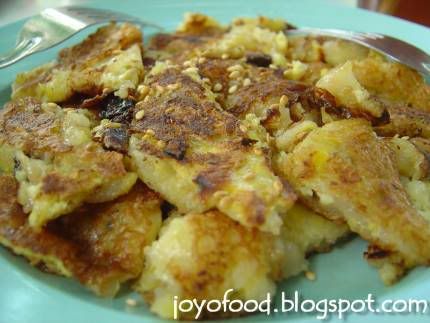
I am not sure whether the chef put in any sugar or not, but the sweetness is just appropriate, maybe it's just the natural sweetness of banana. The pancake is added with banana slices and some raisins. The pancakes are cut into pieces and served with some sesames sprinkled on top.
There are many other food available in the restaurant. Though not bad, but most of them are somehow averagely tasted. Anyway, I do really hope they open up branches in somewhere nearby (in KL) so that I won't be too home-sicked with Penang food!
Chee Cheong Fun - the thick but not stinky gravy earns my vote.
A rice noodle roll (also translated as steamed rice roll) is a Cantonese dish from southern China and Hong Kong, commonly served as a variety of dim sum. It is a thin roll made from a wide strip of Shahe fen (rice noodles), filled with shrimp, pork, vegetables, or other ingredients. Sweet soy sauce is poured over the dish upon serving. A very similar dish is the Vietnamese bánh cuốn.
(Extracted from http://en.wikipedia.org/wiki/Rice_noodle_roll)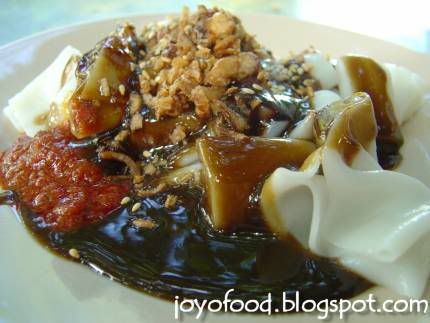
Hokkien Mee - The soup doesn't have stinky smell but tasted average, as in no surprises to me.
(mind you, the "average" is in terms of what you can get in Penang and absolutely does not mean the "average" elsewhere.)
Hokkien hae mee (Hokkien/Fujian prawn noodles; 福建虾麺) is served in Penang (with a variant served in Singapore known as Hae mee). It is a dish of egg noodles and rice noodles in a fragrant stock, which is made from both fresh shrimp and dried prawns, as well as pork or chicken. Traditionally, small cubes of fried pork fat are added to the soup, but this is now less common due to health concerns. It is garnished with prawns, fish cake, leafy greens, pork ribs, squid, vegetables, crisp deep-fried shallots, spring onions and fresh lime. The dish is served with sliced red chili, light soy sauce and sambal.
(Extracted from http://en.wikipedia.org/wiki/Hokkien_mee)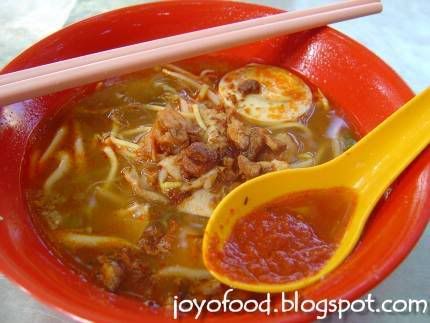
Jawa Mee - Just normal.
Jawa Mee is similar to the Mee rebus. Mee rebus (literally boiled noodles in English) is a Malay inspired noodle dish. It is most popular in Indonesia, Malaysia and Singapore. The dish is made of yellow egg noodles, which are also used in Hokkien mee, with a spicy slightly sweet curry-like gravy.
(Extracted from http://en.wikipedia.org/wiki/Mee_rebus)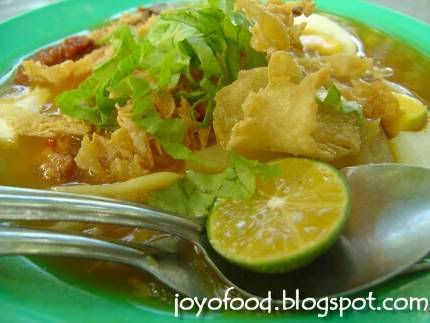
Char Keow Teow - Normal either.
Char kway teow, literally "fried flat noodles", is a popular noodle dish in Malaysia and Singapore. It is made from flat rice noodles (Shāhé fěn or hé fěn in Mandarin), approximately 1 cm or slightly narrower in width, fried over very high heat with light and dark soy sauce, chilli, prawns, cockles, egg, bean sprouts and Chinese chives. Sometimes slices of Chinese sausage and fish cake are added. It is fried in pork fat, with crisp croutons of pork lard, which give it its characteristic taste.
(Extracted from http://en.wikipedia.org/wiki/Char_kway_teow)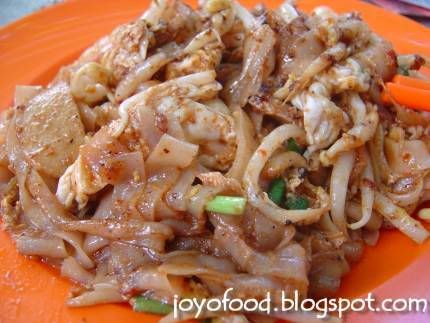
Other Reviews :
http://everythingasian.blogspot.com/2007/12/kedai-kopi-new-cathay-pulau-tikus.html
11.1.08
New Cathay Restaurant, Penang
Tasted by
joy
at
8:08 PM
3
tastebud
![]()
Tags Penang Island
3.1.08
Chai Leng Park Food Court
To my shame, I don't really know the real name for this food court. We always refer that place to Wellesley Cinema Food Court as that place was previously the only cinema at the area, an old-fashioned one. Anyway, this place is besides Wellesley Restaurant, around one block before the Chai Leng Park morning market and a street before the Chai Leng Park's WaiSikKai (the whole street in Chai Leng Park which has lots of food stalls).
There is a good variety of choices there to fill your appetite with yummy food. There are Satay, Char Keow Teow, Keow Teow T'ng (Keow Teow Soup), Belacan Fried Rice, Grilled Fish, Tomyam Noodles, Western food, Curry Mee and many more.
This is a place I would recommend if there are a bunch of you longing for delicious and cheap Penang's hawker food. This is a place where you can have a huge variety of quality food under one roof. However, this place is only opened for dinner.
The food I wouldn't want to miss if I am there :
Grilled Fish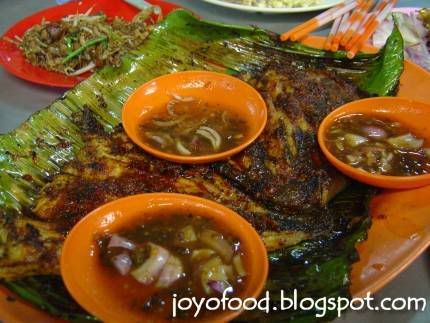
This is so far the best grilled fish that I have ever eaten. The fish is fresh and the meat is tender. The dipping sauce complements the dish perfectly, it is a little bit sour and a bit spicy, adding additional tastes to the already yummy grilled fish and of cause it's very appetizing.
Belacan Fried Rice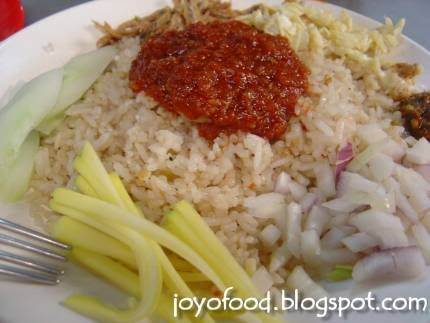
The fried rice above and the fried rice below are from the same stall. I don't really remember the name of the dish, but one of them would be the Belacan Fried Rice. The fried rice has mild saltness. However, the sambal is nice, it's not too spicy if you don't really favour spiciness.
Named "Belacan" in Malay, shrimp paste or shrimp sauce, is a common ingredient used in Southeast Asian and Southern Chinese cuisine.
(Extracted from http://en.wikipedia.org/wiki/Shrimp_paste)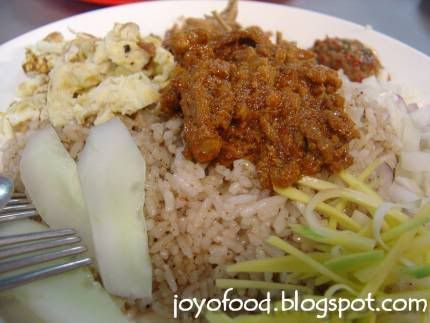
Popiah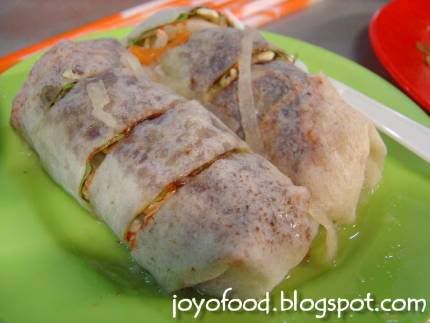
This popiah has generous servings of mengkuang, bean sprouts, chili sauce and other ingredients. To make it not so dry, this variation of popiah has a sweet, fresh soup poured over it before served. I think it is the soup from cooking the bangkuang, which also is the reason why it has mild sweetness.
Popiah (simplified Chinese: 薄饼; pinyin: bóbǐng or Chinese: 薄皮卷; pinyin: bópíjuǎn) is a Hokkien/Chaozhou-style fresh spring roll common in Singapore, Malaysia and Taiwan. The filling is mainly finely grated and steamed jicama (known locally as bangkuang), which has been cooked with a combination of other ingredients such as bean sprouts and lettuce leaves, depending on the individual vendor, along with grated carrots and chopped peanuts or peanut powder.
(Extracted from http://en.wikipedia.org/wiki/Popiah)
Kway Chap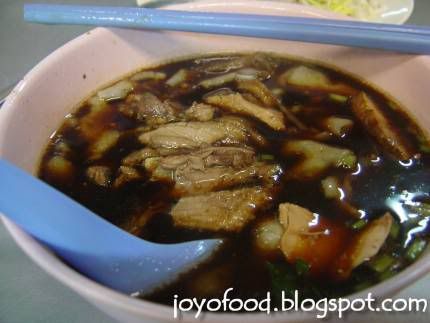
I rarely see this dish elsewhere (or perhaps there are but a variation of it, especially in Selangor). Thus, I make it a point to order this every time I am there. The kuew chap is soft and smooth. The kuew chap itself don't have much taste. However, eating together with the soup and perhaps chilli, the taste is marvelous. The soup is not salty, is not too watery but has very mild herbal taste (perhaps is the dark soya taste instead :P).
Kway chap (Chinese : 粿汁), Teochew dish of rice sheets in dark soya soup, served with pig offal, tofu derivatives and boiled eggs.
(Extracted from http://en.wikipedia.org/wiki/Cuisine_of_Malaysia#Chinese_food)
Oyster Omelette
As I don't really fancy oysters, thus I have no comments on the oyster. But the omelette itself has quite smooth texture and not too dry.
Oyster Omelette ("Oar Jien" in Hokkien) is a Chinese dish which originated in Chaozhou and Fujian. The dish consists of an omelette with a filling primarily composed of small oysters. Starch is mixed into the egg batter, giving the resulting egg wrap a thicker consistency.
(Extracted from http://en.wikipedia.org/wiki/Oyster_omelette)
Satay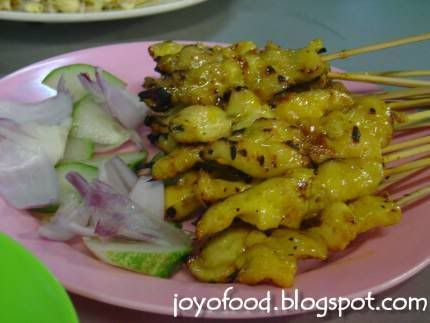
The meat is tender and it is nicely marinated. Unlike some satay from some stalls, there ain't much fat included in the meat, which is something I like. Thus, I think at RM 0.50 per stick, this satay is pretty a good deal compared to some that I have tasted back in KL.
Satay (spelled as sate in both Indonesian and Malay and the Netherlands) is a dish consisting of chunks or slices of dice-sized meat (chicken, goat, mutton, beef, pork, fish, etc.) on bamboo skewers. These are grilled over a wood or charcoal fire, then served with various spicy seasonings (depends on satay recipe variants).
(Extracted from http://en.wikipedia.org/wiki/Satay)
Prawn Dumplings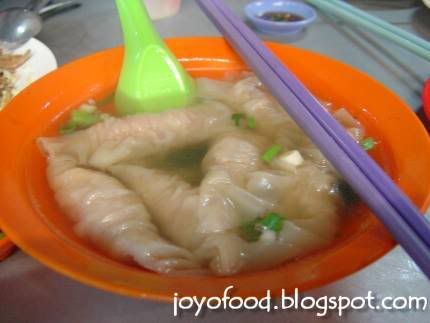
The dumplings use fresh prawn, thus giving a fresh sweetness to the dumplings. However, the soup is just the typical a-little-bit-salty and flavour-engineered soup. :P
Address :
Lebuh Kurau 3, Taman Chai Leng, 13700 Perai, Penang, Malaysia.
(It's at the corner of this road. You will see it immediately when you turn into this road and you can't miss it because it is a one-way road.)
Wikimapia Coordinate :
5°23'5"N 100°23'33"E
Business Hours :
From dinner time until supper time only
Tasted by
joy
at
6:04 PM
0
tastebud
![]()
Tags Perai
1.1.08
Pan Mee and Ramen (Serdang)
There are quite a lot of restaurants and stalls selling pan mee and ramen in Serdang area. Out of these choices, there are these two stalls that have quite a lot of customers frequenting them. They are located opposite the 7-Eleven in Bukit Serdang area.
Pan Mee or Ban Min (Chinese : 板麺) is a Hokkien-style egg noodle soup, some forms of Ban mian, comprises hand-kneaded pieces of dough, while others use regular strips of noodles.
(Extracted from http://en.wikipedia.org/wiki/Cuisine_of_Malaysia)
Ramen (ラーメン or 拉麺, rāmen?, IPA: ['ɺaːmeɴ], listen (help·info)) is a Japanese dish of noodles served in broth that originated in China.
(Extracted from http://en.wikipedia.org/wiki/Ramen)
The restaurants selling pan mee and ramen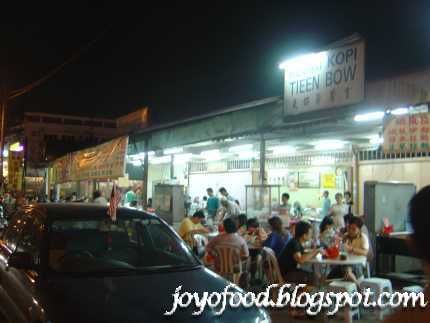
The cheap Spinach Ramen at RM 3
There are dry seaweed, corns, fish balls, pork slices, fried shallots and lots of spinach served together with the greenish mee made with spinach. The soup has a very slight salty taste, nothing extraordinary though. However, the generous servings of the ingredients, the mee and the huge bowl of soup would certainly fill up the whole stomach of an average-eater like me. What's more? It's cheap at RM 3 per huge bowl of mee. There are also other types of noodles served there, but, every time I go there, I always has a good taste of the spinach pan mee as I think it is the best deal of all! Price over quality provided is certainly worth it!
Business Hours :
Night time only.
Wikimapia Coordinate :
3°1'18"N 101°41'58"E
Tasted by
joy
at
12:56 AM
2
tastebud
![]()
Tags Serdang